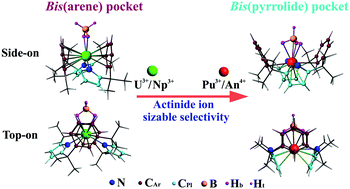Theoretical investigation of low-valent uranium and transuranium complexes of a flexible small-cavity macrocycle: structural, formation reaction and redox properties†
Abstract
The flexible small-cavity macrocycle, trans-calix[2]benzene[2]pyrrolide (H2L), has been found experimentally to complexate low-valent UIII and UIV with binding pockets (BP) of bis(arene) (Ar) and bis(pyrrolide) (Pl), respectively. This switchable coordination of the uranium center has been explored using relativistic density functional theory (DFT) in this work. Systematic calculations of [(BP-L)Anm(η-H)nBH4−n)]z+ (BP = Ar and Pl; An = U, Np and Pu; m = III and IV; n = 2 and 3; and z = 0 and 1), labeled as BP-Anm-nH, were carried out. Energetics and geometrical/electronic-structure analyses reveal that the size matching between actinide ions and the binding pocket plays a significant role in determining the energetic ordering of isomers. The relatively large-size UIII and NpIII ions are selectively preferred by the large bis(arene) pocket, yielding the most stable isomer of Ar-An-2H; simultaneously formed δ(An–Ar2) bonding helps stabilizing the system. In contrast, the small-size PuIII and AnIV are held by the smaller bis(pyrrolide) to show the energetically favored Pl-An-3H isomer. This size argument is further supported by calculations on the related Th and Pa compounds. The formation reactions of BP-Anm-nH demonstrate an endothermic process when using the H2L ligand reactant. Applying a more basic alkali ligand (A2L; A = Li, Na and K) as the reactant significantly reduces the reaction energy and presents thermodynamic possibility to prepare the low-valent actinide complexes. This is in agreement with the experimental synthesis where K2L was utilized. The redox potentials (E0) from tri- to tetravalent actinides were calculated while including both solvation and spin–orbit coupling effects. The highly reductive nature of the UIII complex was manifested by the calculated E0 of over 1.1 V.

- This article is part of the themed collection: Reactions Facilitated by Ligand Design

 Please wait while we load your content...
Please wait while we load your content...